Summary of functions and missions of NASA's 'Perseverance' spacecraft with Mars landing in countdown

by NASA / JPL-Caltech
The Mars probe '
Everything You Need to Know About NASA's Perseverance Rover Landing on Mars --IEEE Spectrum
https://spectrum.ieee.org/automaton/aerospace/robotic-exploration/nasa-perseverance-rover-landing-on-mars-overview
Perseverance is a Mars exploration rover launched in July 2020 with the Mars helicopter ' Ingenuity ' as part of NASA's Mars exploration mission ' Mars 2020 '.
When you access NASA's site ' Eyes on the Solar System ' that displays the major celestial bodies and space exploration missions of the solar system in real time, the Mars 2020 rocket equipped with perseverance is 430,000 km from Mars at the time of writing the article. You can see that it is close to that point.

by NASA
IEEE Spectrum explained the perseverance that is about to enter Mars, focusing on the following seven points.
◆ 1: Purpose and function of perseverance
'The ultimate goal of this exploration rover is to scrutinize specific points to find traces of life that existed in the past,' NASA said of Perseverance. Identify and collect high-value rock cores and soil samples and store them for future missions to return to Earth. Perseverance also tests the technology needed for future Mars exploration. I am. '

by NASA
◆ 2: Difference between Perseverance and conventional Mars rover
NASA launched the Mars probe '
Curiosity (left) and Perseverance (right) are similar in terms of overall design and the use of radioactive isotope-based atomic batteries as the power source, but they are significant in terms of functionality and durability. There is a difference.
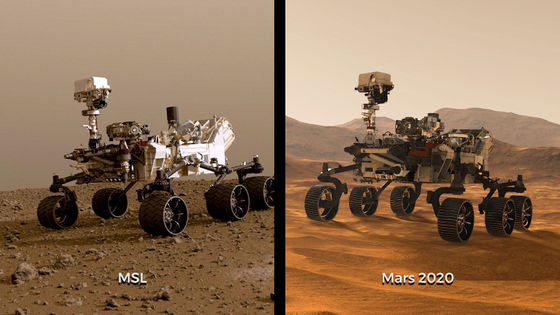
by NASA / JPL-Caltech
According to IEEE Spectrum, Perseverance is about the same size as Curiosity, but weighs nearly 100 kg. Most of this weight difference comes from the weight difference of the robot arm full of SHERLOC, PIXL, drilling drills, etc. mentioned above. In addition, Perseverance is equipped with a total of 23 cameras, five more than Curiosity, and is the first Mars probe to be equipped with a microphone for capturing the 'sound of Mars.'
It also overcomes the problem of 'wheel wear' that Curiosity had. Curiosity is equipped with aluminum wheels, but they wear faster than expected, resulting in unexpected holes and dents in the wheels.
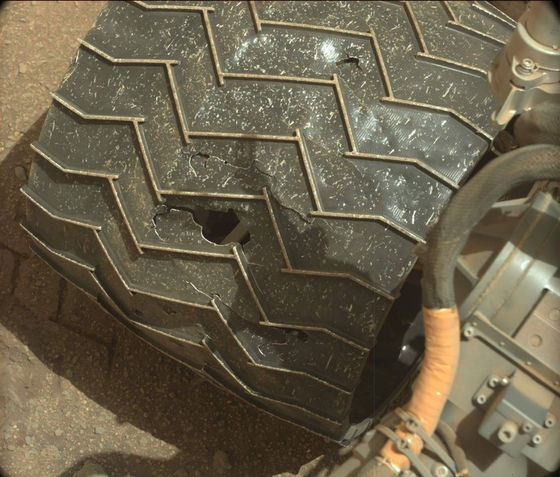
by NASA
On the other hand, the Perseverance wheels (right) are 1mm thicker than the Curiosity wheels (left), which improves resistance to wear while maintaining performance.
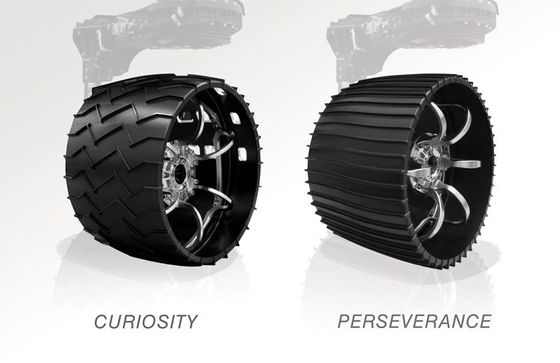
by NASA / JPL
In addition, by enhancing the software, it has acquired higher autonomy than Curiosity, and it is also possible to find a driving route independently and move more efficiently than Curiosity.
◆ 3: Perseverance destination
◆ 4: How to land Perseverance
When the descent unit containing the perseverance approaches the surface of Mars, the parachute first opens to slow down. After that, a power descent is performed in which the landing stage injects propellant to decelerate, and then the 'Sky Crane System' is adopted in which the perseverance is hung by a rope and lands on the ground surface. The aforementioned Curio City also landed on Mars in this way.
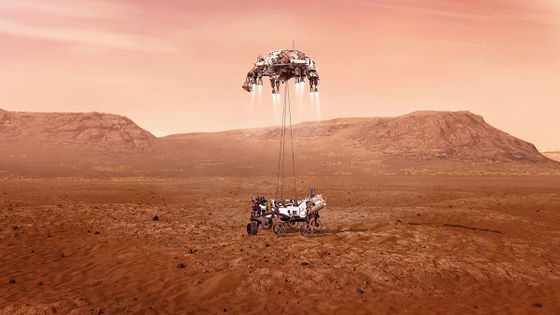
by NASA / JPL-Caltech
◆ 5: What is the Mars helicopter 'Ingenuity'?
The bottom of the Perseverance is also equipped with a heat shielded ingenuity, which will be deployed after the successful landing of the Perseverance and will carry out five flights in 30 days. Ingenuity's main purpose is to test flights on Mars, so unlike Perseverance, it is not used for scientific research, but there are various engineering aspects such as achieving autonomous flight for the first time in the atmosphere of Mars. It is expected to accomplish great things.
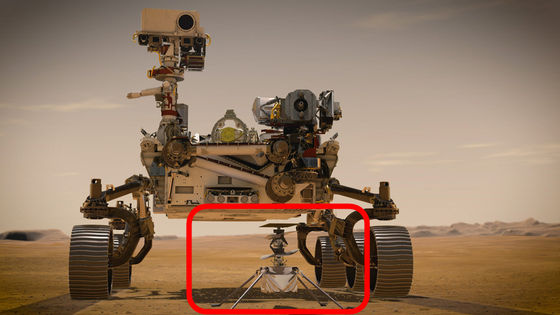
by NASA / JPL-Caltech
◆ 6: How to see the moment of landing of Perseverance?
NASA will broadcast live the appearance of Perseverance landing. The distribution will start on the following YouTube page from 14:15 on February 18th, Eastern Time (4:15 on 19th, Japan time).
Watch NASA's Perseverance Rover Land on Mars! --YouTube
◆ 7: What will happen when the landing is successful or unsuccessful?
Perseverance is scheduled to land on Mars at around 15:55 EST on February 18 (around 5:55 EST on 19th), but because the Earth and Mars are so far apart, they are far from Earth. It is not possible to know the success or failure of landing and its appearance in real time. Perseverance signals NASA's Jet Propulsion Laboratory (JPL) at each stage of landing, from which you can see if the landing is successful.
The IEEE Spectrum says, 'The most likely sign that something is going wrong is that no signal is being sent, but that negative information is not very well communicated and is simply overlooked. It's possible that the problem isn't so big just because it's done. If something goes wrong, there will be a time lag of minutes, hours, or even days before it becomes known. ' Said.
If Perseverance successfully lands on Mars, Perseverance will send you a photo of Mars, but as mentioned above, it will take minutes to hours for the image to reach Earth from Mars. It is a prospect. Also, the photo immediately after landing will be taken with a Perseverance emergency camera, and the camera is likely to have a protective cover attached, so it's not like a great sight. And that. IEEE Spectrum said, 'The high-resolution photos sent by Curiosity were taken after the rover's mast was unfolded, so it will be a while before Perseverance sends similar photos. '.
In addition, Perseverance has its own official Twitter account, so if you want to know the latest information, it seems good to follow it.
If I can make it there, I'll make it anywhere – maybe even Mars. NYC's @EmpireStateBldg is lit up in anticipation of my landing.
— NASA's Perseverance Mars Rover (@NASAPersevere) February 17, 2021
Watch live this Thursday at 11:15 am PST / 2:15 pm EST / 19:15 UTC. Https://t.co/fciqGe8GpC #CountdownToMars pic.twitter.com/gL4ixM0UhY
Related Posts:







